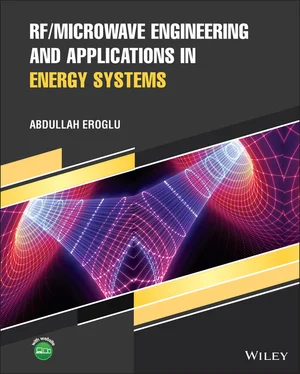Abdullah Eroglu - RF/Microwave Engineering and Applications in Energy Systems
Здесь есть возможность читать онлайн «Abdullah Eroglu - RF/Microwave Engineering and Applications in Energy Systems» — ознакомительный отрывок электронной книги совершенно бесплатно, а после прочтения отрывка купить полную версию. В некоторых случаях можно слушать аудио, скачать через торрент в формате fb2 и присутствует краткое содержание. Жанр: unrecognised, на английском языке. Описание произведения, (предисловие) а так же отзывы посетителей доступны на портале библиотеки ЛибКат.
- Название:RF/Microwave Engineering and Applications in Energy Systems
- Автор:
- Жанр:
- Год:неизвестен
- ISBN:нет данных
- Рейтинг книги:5 / 5. Голосов: 1
-
Избранное:Добавить в избранное
- Отзывы:
-
Ваша оценка:
- 100
- 1
- 2
- 3
- 4
- 5
RF/Microwave Engineering and Applications in Energy Systems: краткое содержание, описание и аннотация
Предлагаем к чтению аннотацию, описание, краткое содержание или предисловие (зависит от того, что написал сам автор книги «RF/Microwave Engineering and Applications in Energy Systems»). Если вы не нашли необходимую информацию о книге — напишите в комментариях, мы постараемся отыскать её.
An essential text with a unique focus on RF and microwave engineering theory and its applications RF/Microwave Engineering and Applications in Energy Systems,
RF/Microwave Engineering and Applications in Energy Systems
RF/Microwave Engineering and Applications in Energy Systems — читать онлайн ознакомительный отрывок
Ниже представлен текст книги, разбитый по страницам. Система сохранения места последней прочитанной страницы, позволяет с удобством читать онлайн бесплатно книгу «RF/Microwave Engineering and Applications in Energy Systems», без необходимости каждый раз заново искать на чём Вы остановились. Поставьте закладку, и сможете в любой момент перейти на страницу, на которой закончили чтение.
Интервал:
Закладка:
10 Chapter 10Figure 10.1 RF PA as a three‐port network.Figure 10.2 Measured gain variation versus frequency for a switched‐mode RF ...Figure 10.3 Multistage RF amplifiers.Figure 10.4 RF system with coupler and attenuation pads.Figure 10.5 Typical closed loop control for an RF power amplifier for linear...Figure 10.6 Linear curve for an RF amplifier.Figure 10.7 Experimental setup for linearity adjustment of RF power amplifie...Figure 10.8 1 dB compression point for amplifiers.Figure 10.9 PA amplifier output response.Figure 10.10 Power gain for linear operation.Figure 10.11 Illustration of IMD frequencies and products.Figure 10.12 Simplified IMD measurement setup.Figure 10.13 Illustration of the relation between fundamental components and...Figure 10.14 Second‐order nonlinear amplifier output response which has comp...Figure 10.15 Third‐order nonlinear amplifier output response which has compo...Figure 10.16 Nonlinear amplifier response which has second‐ and third‐order ...Figure 10.17 BJT circuit with only DC source.Figure 10.18 i cand v CEcurve for DC bias.Figure 10.19 BJT circuit with DC and AC sources.Figure 10.20 i cand v CEcurve with DC and AC sources.Figure 10.21 Fixed bias BJT circuit.Figure 10.22 Stable bias circuit.Figure 10.23 Simplified stable bias circuit.Figure 10.24 Self‐bias circuit.Figure 10.25 Emitter bias circuit.Figure 10.26 (a) Bias circuit with temperature compensating diodes. (b) Acti...Figure 10.27 Bias circuit using linear regulator.Figure 10.28 (a) Stable bias circuit. (b) Self‐bias circuit. (c) Source bias...Figure 10.29 Generalized two‐port network.Figure 10.30 Integration of amplifier circuit.Figure 10.31 General two‐port amplifier network.Figure 10.32 Small signal amplifier design method illustration.Figure 10.33 Smith chart illustrating output stability regions.Figure 10.34 Smith chart illustrating input stability regions.Figure 10.35 Unconditional stability: (a) Γ Lplane; (b) Γ splane.Figure 10.36 Stability circles for Example 10.8.Figure 10.37 Two‐port network for stabilization.Figure 10.38 Stabilization network by adding series resistance.Figure 10.39 Stabilization network by adding shunt conductance.Figure 10.40 Stabilization with series resistor at the load.Figure 10.41 Stabilization with shunt conductance at the load.Figure 10.42 Unilateral amplifier design.Figure 10.43 Drawing constant gain circles.Figure 10.44 (a) ATF‐54143 die model provided by Avago [4] (b) DC biasing ci...Figure 10.45 ATF‐54143 die model provided by Avago.Figure 10.46 I dvs V dsprovided by the manufacturer, Avago [4]Figure 10.47 ATF‐54143 I dvs V gsand I dvs V dsobtained from ADS.Figure 10.48 Input and output stability circles at 915 MHz.Figure 10.49 Input matching circuit.Figure 10.50 Output matching circuit.Figure 10.51 Constant gain circles at the input.Figure 10.52 Constant gain circles at the output.Figure 10.53 Simulation of the final circuit with ADS.Figure 10.54 ADS simulation results of the final circuit with ADS.Figure 10.55 The prototype of the low noise amplifier build and tested.Figure 10.56 Problem 10.1.Figure 10.57 Problem 10.3.Figure 10.58 Problem 10.4.Figure 10.59 Problem 10.5.Figure 10.60 Problem 10.6.Figure 10.61 Problem 10.7.
11 Chapter 11Figure 11.1 Several antenna types.Figure 11.2 Illustration of field regions.Figure 11.3 Radiation patterns: (a) polar plot; (b) rectangular plot.Figure 11.4 Illustration of HPBW.Figure 11.5 Equivalent circuits: (a) transmitter antenna; (b) receiver anten...Figure 11.6 Illustration for Friis relation.Figure 11.7 Illustration of Friis relation for radar cross section.Figure 11.8 Power pattern for Example 11.1.Figure 11.9 Hertzian dipole located at the origin.Figure 11.10 Input and output for the case of finite wire antenna.Figure 11.11 Half‐wave dipole geometry.Figure 11.12 Excitation port of half‐wave dipole.Figure 11.13 S 11dB from HFSS.Figure 11.14 Real and imaginary parts of Z parameter from HFSS.Figure 11.15 Two‐dimensional radiation pattern result from HFSS.Figure 11.16 Three‐dimensional polar plot of E along the half‐wave dipole an...Figure 11.17 Geometry of microstrip antennas.Figure 11.18 Microstrip patch antenna shapes [2].Figure 11.19 Microstrip feeding method illustration: (a) microstrip line fee...Figure 11.20 Microstrip feed line.Figure 11.21 Proximity coupled feed.Figure 11.22 Rectangular patch and its transmission model equivalent.Figure 11.23 Inset feed point distance ( y 0).Figure 11.24 Layout of dual band slot loaded antenna layout.Figure 11.25 Simulated return loss for dual band antenna.Figure 11.26 Gain (dBi) in 900 MHz and 1.8 GHz.Figure 11.27 Two‐dimensional radiation pattern 900 MHz/1.8 GHz (Phi = 0° and...Figure 11.28 Prototype antenna built and measured.Figure 11.29 Radiation plot by MATLAB.Figure 11.30 Three‐dimensional layout of the half dipole antenna by HFSS.Figure 11.31 Antenna parameters from HFSS.Figure 11.32 VSWR response of half dipole antenna.Figure 11.33 S 11of the half‐wave dipole.Figure 11.34 Two‐dimensional radiation plot at f = 146 MHz.Figure 11.35 Dipole antenna construction.Figure 11.36 Close‐up view of dipole antenna connections.Figure 11.37 Measured S 11reflection coefficient magnitude.Figure 11.38 Measured phase of S 11reflection coefficient.Figure 11.39 Measured radiation pattern.
12 Chapter 12Figure 12.1 Basic diagram of RFID system.Figure 12.2 Electronic product code.Figure 12.3 Example of IMD and communication system.Figure 12.4 Layout of the meandered antenna.Figure 12.5 Dual linear meandered antenna for dual band operation.Figure 12.6 Final layout of the dual band antenna.Figure 12.7 Return loss for dual band antenna.Figure 12.8 Meander antenna layout.Figure 12.9 Modeling of meander line T network.Figure 12.10 T network model of meander line antenna.Figure 12.11 (a) T network ABCD matrix two‐port model. (b) T network represe...Figure 12.12 Final cascaded system.Figure 12.13 T network circuit of antenna prototype modeled in ADS.Figure 12.14 S 11parameter simulation result using ADS.Figure 12.15 Top and side views of antenna prototype in skin‐mimicking box....Figure 12.16 S 11parameter values from HFSS for the antenna in free space a...Figure 12.17 Two‐dimensional polar plot of gain for implantable antenna in s...Figure 12.18 Two‐dimensional polar plot comparison of gain for implantable a...Figure 12.19 Two‐dimensional polar plot of gain for implantable antenna in s...Figure 12.20 Skin‐mimicking at f = 2.5441 GHz, free space at f = 2.5998 GHz....Figure 12.21 Three‐dimensional polar plot of gain at f = 0.4493 GHz in skin‐...Figure 12.22 Three‐dimensional polar plot of gain at f = 2.5451 GHz in skin‐...Figure 12.23 (a) Antenna patch and substrate‐top layer. (b) Superstrate.Figure 12.24 Comparison of S 11parameter values without and with superstrate...
13 Chapter 13Figure 13.1 Sources of energy harvesting [1].Figure 13.2 Standard HVAC system without control electronics.Figure 13.3 System overview of radiofrequency energy harvesting system.Figure 13.4 Impedance matching network implementation for antennaFigure 13.5 Two‐section dual band transformer.Figure 13.6 Positive clamper circuit.Figure 13.7 Peak detector circuit.Figure 13.8 Single stage cascaded rectifier.Figure 13.9 Single stage Villard voltage doubler.Figure 13.10 Efficiency of rectifier versus number of stages.Figure 13.11 Diode connected PMOS transistor with internal threshold cancell...Figure 13.12 Voltage multiplier with external threshold voltage cancellation...Figure 13.13 Self V thcancellation with CMOS rectifier circuit.Figure 13.14 Wireless sensors and antennas implementation for HVAC systems [...Figure 13.15 RF–DC rectifier based on Dickson's topology.Figure 13.16 (a) Three stages rectifier. (b) Five stages rectifier output in...Figure 13.17 Transient analysis of three stages rectifier output voltage.Figure 13.18 Self‐resonant transformer‐based DC–DC boost converter circuit s...Figure 13.19 Booster output voltage from transient simulation.Figure 13.20 Switch mode DC–DC boost converter using N channel MOSFET.Figure 13.21 (a) Top and (b) bottom view of the rectifier.Figure 13.22 RF–DC rectifier output voltage.Figure 13.23 Self‐resonant transformer‐based DC–DC boost converter output vo...Figure 13.24 Output voltage of the self‐resonant transformer based booster w...Figure 13.25 Block diagram of the RFEH output measurement.Figure 13.26 Energy harvester test setup.Figure 13.27 Signals at the input of the rectifier at 900 MHz: (a) RF power ...Figure 13.28 Signals at the input of the rectifier at 2.4 GHz: (a) RF power ...Figure 13.29 Final measured output voltage of the RFEH by DMM.Figure 13.30 Proposed dual band meander antenna design for 900 MHz and 2.4 G...Figure 13.31 Initial simulation results for dual band meander antenna.Figure 13.32 (a) Meander sections. (b) T network model for a meander section...Figure 13.33 T network model of the square bend join.Figure 13.34 Complete T network model of the antenna design.Figure 13.35 Physical dimension calculation for the layout (a) Top view (b) ...Figure 13.36 Return loss of the T network model.Figure 13.37 Impedance variation over the desired frequency range of 900 MHz...Figure 13.38 Two‐dimensional directivity plot showing the maximum directivit...Figure 13.39 Final layout for the simulated dual band meander antenna in HFS...Figure 13.40 Simulation results of the final dual band energy harvester ante...Figure 13.41 Simulation results after all dimensions are parametrized and ch...Figure 13.42 (a) Simulated gain. (b) Simulated directivity.Figure 13.43 KiCAD EDA layout of the antenna design.Figure 13.44 (a) Front side of the PCB layout. (b) Back side of the PCB desi...Figure 13.45 (a) Bantam PCB milling tool used to fabricate the antenna. (b) ...Figure 13.46 Measurement setup for dual band energy harvester antenna.Figure 13.47 Measurement results for return loss for energy harvester antenn...Figure 13.48 Comparison of measurement and simulated results.Figure 13.49 Typical HVAC ECM enclosure.Figure 13.50 Antenna location for ECM.Figure 13.51 (a) F antenna HFSS model. (b) inverted F antenna HFSS model.Figure 13.52 Comparison of measurement and simulation results for inverted F...Figure 13.53 Comparison of measurement and simulation results for F antenna....Figure 13.54 (a) ECM cover with dielectric encapsulation for interface conne...
Читать дальшеИнтервал:
Закладка:
Похожие книги на «RF/Microwave Engineering and Applications in Energy Systems»
Представляем Вашему вниманию похожие книги на «RF/Microwave Engineering and Applications in Energy Systems» списком для выбора. Мы отобрали схожую по названию и смыслу литературу в надежде предоставить читателям больше вариантов отыскать новые, интересные, ещё непрочитанные произведения.
Обсуждение, отзывы о книге «RF/Microwave Engineering and Applications in Energy Systems» и просто собственные мнения читателей. Оставьте ваши комментарии, напишите, что Вы думаете о произведении, его смысле или главных героях. Укажите что конкретно понравилось, а что нет, и почему Вы так считаете.












